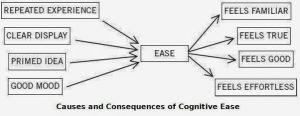When you improve conversion rates, what you’re really doing is persuading more people to take a desired action, whether it’s to make a purchase, sign up for a list, or download a form.
And if you want to be more persuasive, an understanding of psychological principles, especially those that apply to consumer psychology, is key.
Below, you’ll learn about three psychology “tricks” you can use on your landing page to increase conversion rates.
Cognitive Ease Or Fluency
Cognitive ease or fluency refers to the “measure of how easy it is for [people’s] brains to process information.” And how easy or challenging people perceive something to be to think about affects how they feel about that particular thing and whether or not they’re willing to invest their time, effort, or money into it.

Unsurprisingly, people prefer thinking about things that are easy as opposed to things that are more complex or challenging. And consequently, people feel better about investing in things that are easier to think about (no-brainers, if you will).
The way you can incorporate this psychological principle into your landing page is by keeping it simple and not overwhelming visitors with excess information or fancy design elements.
Also, include lots of white space.
White space provides “visual breathing room for the eye,” says The Segue Creative Team. White space gives visitors a break, allowing them to digest the information they’ve already seen before being hit with something new.
And according to the principle of cognitive ease or fluency, this break helps visitors to feel more positive about your homepage because it’s easier to process.
Reciprocity
According to this law of social psychology, humans have a tendency to want to pay back that which they’ve received from others. In other words, people feel compelled to return favors.

Image Source
So, for example, on your landing page, you could include an offer for something free, like a coupon code, eBook, free trial, or a sample of your product. If visitors feel as if you’re doing them a solid, they’ll be more likely to do something for you in return (e.g. make a purchase).
Plus, giving something away for free helps ease people’s minds about spending their money with you. It also improves UX and fosters trustworthiness.
But in order to make reciprocity work as well online as it does offline, you need to be mindful that when people can stay anonymous, they may not be as apt to reciprocate.
To counteract this, after people receive your initial free offer from your landing page…
- Show your face. Egor Driagin reports, “Reversing anonymity increased compliance rates.” So in any subsequent emails you send, include your photo, as doing so can make recipients more likely to comply with what’s being asked of them.
- Follow up. Check in to see how things are going for people with their free gift, trial, or coupon code. Following up lets people know they’re on your radar so they’re less likely to feel anonymous and more likely to view you as authentic.
- Exceed expectations. If you offered a free trial, extend it. If you provided a coupon code, sweeten the deal with free shipping. Doing something above and beyond makes people more likely to reciprocate.
Pointing Out Others’ Satisfaction
Most people don’t want to be guinea pigs when it comes to trying new products or services. Most people want to know that other people have made the investment before them and felt satisfied with their purchases.
So, in the vein of social proof, when you point out the number of customers who’ve purchased a product or service, you put new, potential buyers’ minds at ease.
Social proof relies on acquiring testimonials, reviews, and things like shares, likes, and retweets. Pointing out others’ satisfaction or success, however, is simpler and easier to convey.
To indicate the satisfaction of other customers, you might say something like the following on your homepage (depending on your offer):
- Join more than 500,000 people already experiencing the benefits…
- Become part of a community of over 200,000 subscribers…
- Enter your email address to join 10,568 others…

Businesses use this psychological tactic a lot, especially when trying to persuade more people to sign up for their newsletters. And the impact can be significant, instilling confidence in shoppers that purchasing from you is a good and safe bet.
What do you think about these psychology-backed techniques to improve your conversion rates? Contact us via social media and share your insights!




